The transformation of a downtown Honolulu office building into a residential tower marks a bit of a seismic shift in the land use world.
The building at 1132 Bishop St. is in the home stretch — now The Residences at Bishop Place. It's still home to the federal bankruptcy courthouse, but the floors above are largely apartments for rent.
Douglas Emmett, a real estate investment trust, determined it could make more money for its shareholders by converting the high-rise into a housing complex with amenities.

The idea came from a 2018 dinner meeting with Hawaiʻi developer Jay Shidler.
"Jay was talking to us about island economies and how they're different from other places... and we realized that we had an office portfolio that was perpetually 80-something percent leased, and we had a multifamily portfolio that was perpetually 98%, 99% leased," said Kevin Crummy, chief investment officer for Douglas Emmett.
One challenge was getting office tenants out of the building while starting construction floor by floor. But many tenants want out if they know the interruption is imminent, Crummy said.
"We should have the majority of the 493 units built by the end of this year, but we still have one or two floors where tenants are in occupancy that we might not get back for a couple of years," he told The Conversation.
"There were challenges on just figuring out how to make an office building into resi(dential) because when you look at your ideal high-rise apartment building, it's pretty skinny and long," Crummy said. "The closer you get to a square, the more difficult it is to build because you end up with really deep units."
The developer worked with the city to use a powerful housing incentive called 201H that waives some building requirements to generate more affordable units. The finished plan has 252 affordable units, according to the website.
Every bedroom is usually required to have an external window but The Residences at Bishop Place was able to use opaque, sliding glass doors for certain units.

"You still pick up natural light, and it affords you a big living area right off your kitchen... and then we also did not put in operable windows in the building. And that was a choice, it really came down to economics. Replacing all of the glass in that building would have made the project too expensive," Crummy said.
Crummy said the market has accepted the layouts — nearly all of the roughly 350 completed units already have residents.
As for future projects from other developers in downtown and Chinatown, he said the more flexible the city can be with adaptive reuse laws, the more buildings could get converted.
"I think that we may have kicked off something that other people are picking it up. I know that Davies Pacific is going to be converting some of their units into multifamily," Crummy said. "Candidly, if we can get more people downtown, out on the streets at all hours, it's also going to make downtown a little less gritty."
This interview aired on The Conversation on March 21, 2023. The Conversation airs weekdays at 11 a.m. on HPR-1.












